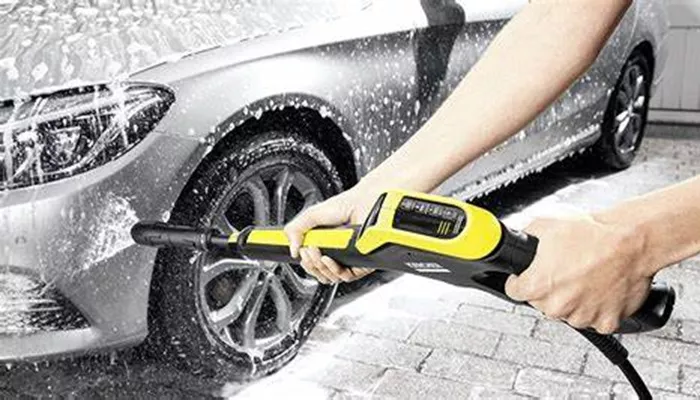To automate the task of window cleaning, Skyline developed “Ozmo,” a system that combines industrial robots, computer vision systems, artificial intelligence (AI), and machine learning.
Ozmo can now do the work that previously took three to four months of manual labor in about half the time. Most importantly, the system eliminates the need for human operators to operate the window-cleaning platform or “basket,” ensuring safety.
Manual window cleaning requires three to four people—two in the basket, one on the roof, and sometimes one person on the ground. With Ozmo, the robot can clean with just one person on the roof, controlling the basket, power, water, and crane.
Ozmo’s power and water systems are designed to be compatible with a building’s existing building maintenance unit (BMU) infrastructure. A table inside its basket houses several types of sensors and computers.
The robotic arm and its lidar (light detection and ranging) camera, which uses lasers for imaging, are mounted on a table. The table clips into a building’s existing window-washing basket, and the system goes to work.
Ross Blum, COO of Skyline Robotics, said the Skyline team has been working on the Ozmo project for the past five years, taking iterative steps to integrate all the necessary technologies along the way.
That includes the industrial robot itself and the programming that enables its arm to mimic human movements to clean windows.
“The robotic arm communicates with a lidar camera that provides the robot with ‘vision,’ and with a torque sensor on the end of the cleaning brush that gives Ozmo a ‘sense of touch,’” Blum said.
“The system software acts as the brain, collecting data from multiple different cameras and sensors about 200 times per second to adjust the robot’s movements and achieve the most efficient cleaning path, while automatically lowering Ozmo down the side of a skyscraper.” ”
For the Ozmo system, Skyline used a waterproof version of the Kuka Robotics KR Agilus industrial robot combined with software-based AI to enable the window washing application.
Skyline developed an algorithm that provides feedback on force control and other variables to control the pressure the robot applies to the glass.
The robot has an operating reach of up to 1.1 meters. “One of the biggest factors in Skyline choosing KUKA was not only because of the brand’s reputation and the world-class team behind it, but also because KUKA’s robotic arms can handle the rigors of outdoor environments, which most other brands cannot,” said Blum. ”
The robots are IP65-rated and reliable, he continued, and their six-axis motion is important to Skyline, especially when approaching complex facade geometries encountered on buildings.
The Kuka KR C5 microcontroller also played a major role in meeting the varying basket weight limits around the world. The controller is 35 pounds lighter than other controllers and takes up less space. In some cases, Skyline can put multiple arms in a basket, even with the lower weight limits.
“We want to be a leader in taking robots out of controlled environments,” Blum said.
To achieve this goal, we believe Kuka is the automation supplier to work with. They are willing to take robotics beyond typical applications.
All of Ozmo’s technologies are extremely advanced, especially its software and world-class hardware components. These technologies enable Skyline to not only control and adjust the robot’s motion in real time, but also stabilize the system basket/platform that the robot is riding on in real time.
What makes this work so challenging is that it must accommodate unexpected variables such as gusts of wind or crane failures, which can cause one side of the basket to drop further than the other.
Ozmo can handle all of these variables and compensate instantly to ensure a quality clean and the most efficient descent path.
To achieve stability, Ozmo leverages the KUKA arm itself to apply a counterforce to an unstable basket. The robot’s arm pushes against the building’s window for half a second to prevent the basket from wobbling. According to Blum, Skyline is the first and only robotics company to successfully use a robotic arm in this way.
“A lot of robotics companies want to get into the automated window cleaning business,” said Michael Brown, chairman and CEO of Skyline Robotics.
However, the truth is that doing so is extremely complex and requires a lot of math, especially when it comes to artificial intelligence and machine learning. You can’t just put a robot in a basket and think you’re done.
“We’ve been working with window cleaners for years to refine our system and make sure it has the necessary algorithms for all possible variables.”
Brown also noted that partnerships have been critical to Ozmo’s development. “KUKA has advised us every step of the way, and we really couldn’t have asked for a better partner.” ”
“Once we have completed what I call the proof of concept phase in New York, we plan to meet with Kuka again to discuss and gain deeper insights into how we can adapt or further improve our products using their technology. For us, the collaboration with Kuka is critical to the success of our business. ”
Related topics:
- Spring Sale: Electric Pressure Washers Drop from £100 to Under £30
- Greenworks 2,300 PSI Pro Washer Debuts at \$280, More from \$128
- High-Pressure Cleaner Damages 29 Floors of Birmingham High-Rise

